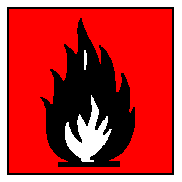International Chemical Safety Cards
| ACETONE | ICSC: 0087 |
| ACETONE 2-Propanone Dimethyl ketone Methyl ketone C3H6O/CH3-CO-CH3 Molecular mass: 58.1 CAS # 67-64-1 RTECS # AL3150000 ICSC # 0087 UN # 1090 EC # 606-001-00-8 |
 |
| TYPES OF HAZARD/ EXPOSURE |
ACUTE HAZARDS/ SYMPTOMS |
PREVENTION | FIRST AID/ FIRE FIGHTING |
| FIRE | Highly flammable. |
NO open flames, NO sparks,
and NO smoking. |
Powder, alcohol-resistant
foam, water in large amounts, carbon dioxide. |
| EXPLOSION | Vapour/air mixtures are
explosive. |
Closed system, ventilation,
explosion-proof electrical equipment and lighting. Do NOT use compressed air for filling,
discharging, or handling. |
In case of fire: keep
drums, etc., cool by spraying with water. |
| EXPOSURE | |
|
|
| INHALATION | Sore throat. Cough.
Confusion. Headache. Dizziness. Drowsiness. Unconsciousness. |
Ventilation, local exhaust,
or breathing protection. |
Fresh air, rest. Refer for
medical attention. |
| SKIN | Dry skin. |
Protective gloves. |
Remove contaminated
clothes. Rinse skin with plenty of water or shower. |
| EYES | Redness. Pain. Blurred
vision. Possible corneal damage. |
Safety spectacles or face
shield. Contact lenses should not be worn. |
First rinse with plenty of
water for several minutes (remove contact lenses if easily possible), then take to a
doctor. |
| INGESTION | Nausea. Vomiting (further
see Inhalation). |
Do not eat, drink, or smoke
during work. |
Rinse mouth. Refer for
medical attention. |
| SPILLAGE DISPOSAL | STORAGE | PACKAGING & LABELLING | ||
| Ventilation. Collect
leaking liquid in sealable containers. Absorb remaining liquid in sand or inert absorbent
and remove to safe place. Do NOT wash away into sewer. Then wash away with plenty of
water (extra personal protection: self-contained breathing apparatus). |
Fireproof. Separated from
strong oxidants. |
F symbol R: 11 S: (2-)9-16-23-33 UN Hazard Class: 3 UN Packing Group: II |
||
| SEE IMPORTANT INFORMATION ON BACK | ||||
|
||||